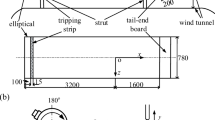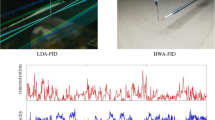Abstract
Two-point measurements of the streamwise velocity in a turbulent channel flow are performed using laser-Doppler anemometry. High spatial and temporal resolutions (about 1 Kolmogorov microscale in space and time) are achieved. Data are obtained at several distances from the wall for Re δ in the range 1500–5000. Results from correlation functions are compared with the hypotheses of Taylor and Tennekes: they reproduce the experimental data even at low Reynolds numbers and small distances from the wall, providing that convection rather than mean velocity is used. Convection velocities are computed from transfer function phase diagrams: the ratio of convection to mean flow velocity is found to decrease with increasing Reynolds number and distance from the wall. Large flow structures are convected with the local mean velocity rather than the test section mean velocity; data at small Reynolds and close to the wall exhibit convection velocities lying between the two. The good agreement between the time evolution of the envelope of space-time-correlation function with the corresponding Lagrangian correlation over one integral time scale confirms the existence of a strict relation between the Eulerian and Lagrangian descriptions of turbulence.
Similar content being viewed by others
Abbreviations
- A :
-
upstream measurement point
- B :
-
downstream measurement point
- d :
-
seeding particle size
- f :
-
frequency
- f * :
-
non-dimensional frequency (using Taylor time microscale)
- H AB (f) :
-
transfer function between signals at points A and B
- ¦H AB (f)¦:
-
modulus of transfer function
- L ɛ :
-
dissipation length scale
- L E :
-
Eulerian space integral scale
- N D :
-
valid data density
- r :
-
distance between points A and B
- R A,B (τ):
-
time correlation function at point A or B
- R AB (τ):
-
space-time correlation function between points A and B
- R AB (r) :
-
space correlation function between points A and B
- Re δ :
-
Reynolds number based on half channel height
- Re λ :
-
Reynolds number based on Taylor microscale
- S A,B (f) :
-
auto-spectral power density at point A or B
- S A B(f) :
-
cross-spectral power density between points A and B
- ¦S AB (f)¦:
-
modulus of cross-spectral power density
- u′ :
-
rms of streamwise fluctuating velocity
- u * :
-
friction velocity
- u A,B (t) :
-
velocity at point A or B
- U :
-
mean flow velocity in the entire test section
- U c :
-
convection velocity
- U l :
-
local mean flow velocity
- t :
-
time
- t + :
-
time in wall units
- t * :
-
non-dimensional time (using Eulerian or Lagrangian integral time scale)
- T :
-
total sampling time
- T E :
-
Eulerian integral time scale
- T L :
-
Lagrangian integral time scale
- x,y :
-
z reference frame coordinates
- y + :
-
distance from the wall in wall units
- β :
-
ratio between Lagrangian and Eulerian integral time scales
- γ AB (f) :
-
coherence function between signals at points A and B
- δ :
-
half channel height
- Δ r/r :
-
relative error on distance evaluations
- ΔU/U :
-
relative error on velocity measurements
- ɛ :
-
mean energy dissipation
- 0 AB (f) :
-
phase of cross-spectral power density
- η :
-
Kolmogorov scale
- λ :
-
Taylor length microscale
- ν :
-
kinematic viscosity
- ρ L :
-
Lagrangian correlation coefficient
- Σ :
-
mean displacement of fluid particles
- τ :
-
time lag
- τ 0 :
-
fixed time lag
- τ λ :
-
Taylor time microscale
- φ AB (f) :
-
phase of transfer function
References
Adrian RJ (1988) Linking correlations and structure: stochastic estimation and conditional averaging. In: Near wall turbulenceZoran Zaric Memorial Conf. (Kline SJ; Afgan NH, eds.), pp 420–436. New York: Hemisphere
Adrian RJ; Yao CS (1987) Power spectra of fluid velocities measured by laser Doppler velocimetry. Exp Fluids 5: 17–28
Antonia RA; Browne LWB; Bisset DK (1988) Effect of Reynolds number on the organized motion in a turbulent boundary layer. In: Near wall turbulence-Zoran Zaric Memorial Conf. (Kline SJ; Afgan NH, eds.), pp 488–505. New York: Hemisphere
Balint JL; Piomelli U; Wallace JM (1989) On the validity of Taylor hypothesis for wall-bounded flows. Phys Fluids Al: 609–611
Bendat JS; Piersol AG (1971) Random data: analysis and measurement procedures. New York: Wiley-Interscience
Benak M; Sturm M; Tropea CD (1993) Correlation estimators for two-point laser Doppler anemometry. In: Laser anemometry — advances and applications. SPIE Vol 2052, pp 613–622
Berkooz G; Holmes P; Lumley JL (1993) The proper orthogonal decomposition in the analysis of turbulent flows. Ann Rev Fluid Mech 25: 539–575
Buchhave P; George WK; Lumley JL (1979) The measurement of turbulence with the laser Doppler anemometry. Ann Rev Fluid Mech 11: 443–503
Cenedese A; Costantini A; Romano GP (1992) LDA spectral measurements in a turbulent boundary layer. Exp Thermal Fluid Sci 5: 281–289
Cenedese A; Di Felice F; Romano GP (1991) Experimental testing of Taylor's hypothesis by LDA in highly turbulent flow. Exp Fluids 11: 351–358
Champagne FH; Harris G; Corssin S (1970) Experiments on nearly homogeneous turbulent shear flow. J Fluid Mech 41: 281–322
Corssin S (1963) Estimates of the relations between Eulerian and Lagrangian scales in large Reynolds number turbulence. J Atm Sci 20: 115–119
Dumas R (1988) Observations on the boundary layer based on measured correlations with various improvements. In: Near wall turbulence-Zoran Zaric Memorial Conf. (Kline SJ; Afgan NH, eds.), pp 437–452. Hemisphere
Edwards RV (1987) Report of the special panel on statistical particle bias problems in laser anemometry. J Fluids Eng 109: 89–93
Favre AJ; Gaviglio JJ; Dumas R (1957) Space-time double correlations and spectra in a turbulent boundary layer. J Fluid Mech 2: 313–342
Fisher MJ; Davies POAL (1963) Correlation measurements in a nonfrozen pattern of turbulence. J Fluid Mech 18: 97–116
Fung JCH; Hunt JCR; Malik NA; Perkins RJ (1992) Kinematic simulation of homogeneous turbulence by unsteady random Fourier modes. J Fluid Mech 236: 281–318
George WK (1974) The measurement of turbulence intensities using real-time laser-Doppler velocimetry. J Fluid Mech 66: 11–16
George WK; Lumley JL (1973) The laser Doppler velocimeter and its application to the measurement of turbulence. J Fluid Mech 60: 321–362
Gerosa S; Romano GP (1994) Effect of noise in Laser Doppler Anemometry. Mech Systems Signal Proces 8: 229–242
Hinze JO (1975) Turbulence. New York: McGraw-Hill
Moin P; Spalart PR (1989) Contributions of numerical simulation data bases to the physics, modeling and measurement of turbulence. In: Advances in turbulence (George, WK; Arndt R, eds.), pp 11–36, New York: Hemisphere
Morton JB; Clark WH (1971) Measurements of two-point velocity correlations in a pipe flow using laser anemometers. J Phys E: Scient Instrum 4: 809–814
Nicolaenko B; She ZS (1990) Turbulent bursts, inertial sets and simmetry-breaking homoclinic cycles in periodic Navier-Stokes flows: In: Turbulence in fluid flows — A dynamical systems approach (Sell GR; Foias C; Temam R, eds.) pp 123–136. Berlin: Springer
Pedrizzetti G; Novikov EA (1994) On Markov modelling of turbulence. Accepted in: J Fluid Mech
Romano GP (1993) Two-point velocity measurements using LDA: spatial and temporal analysis in a turbulent boundary layer. In: Laser anemometry — Advances and applications, SPIE Vol 2052, pp 597–604
Sato Y; Yamamoto K (1987) Lagrangian measurement of fluid-particle motion in an isotropic turbulent field. J Fluid Mech 175: 183–199
Squires KD; Eaton JK (1991) Lagrangian and Eulerian statistics obtained from direct numerical simulations of homogeneous turbulence. Phys Fluids A3: 130–143
Taylor JT (1938) The spectrum of turbulence. Proc Roy Soc A164
Tennekes H (1975) Eulerian and Lagrangian time microscales in isotropic turbulence. J Fluid Mech 67: 561–567
Tropea CD (1993) Refined turbulence measurements using laser Doppler anemometry. In: Refined flow modelling and turbulence measurements, pp 257–268. Presses de l'Ecole Nationale des Ponts et Chaussees
Yeoung PK; Pope SB (1989) Lagrangian statistics from direct numerical simulations of isotropic turbulence. J Fluid Mech 207: 531–586
Author information
Authors and Affiliations
Additional information
The present work was supported by the Italian University, Scientific Research and Technology Office (MURST). The author is grateful to Prof. A. Cenedese for very useful suggestions and discussions, to Prof. R.A. Antonia for valuable comments on the manuscript and to Prof. G. Seminara for revision of the paper. The author would also like to thank Prof. C. Tropea for encouraging the publication of the paper. Stimulating discussions were provided by Drs. F. Di Felice, G. Leuzzi, P. Monti and G. Querzoli. Special thanks to Dr. S. Gerosa and D. Pietrogiacomi for help with the measurements.
Rights and permissions
About this article
Cite this article
Romano, G.P. Analysis of two-point velocity measurements in near-wall flows. Experiments in Fluids 20, 68–83 (1995). https://doi.org/10.1007/BF00189296
Received:
Accepted:
Issue Date:
DOI: https://doi.org/10.1007/BF00189296




